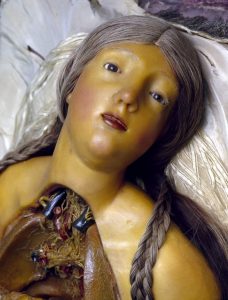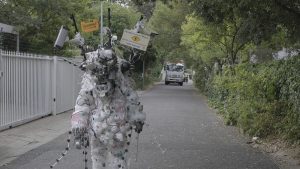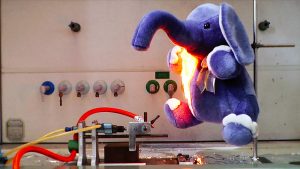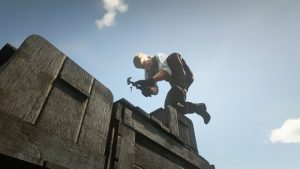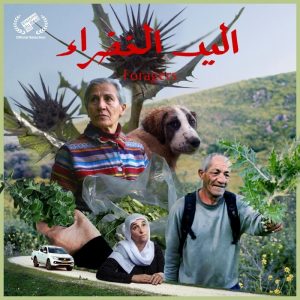Today people will look down on you if your art space doesn’t have an exhibition dedicated to ecological issues on its agenda. Unsurprisingly, Milan still hasn’t organized anything worth mentioning but her little neighbour, the enlightened and chilly Turin, did. The show is called Greenwashing. Environment, Perils, Promises and Perplexities and is on view at the Fondazione Rebaudengo until May 11, 2008.
Here’s the premise: The diverse practices represented in the exhibition do not just point the finger at the degradation of our planet, they also make more tangible the contradictions and responsibilities that we encounter personally and as a society. Art here does not necessarily proclaim a ‘correct’ ethical or green choice, but allows the possibility for broadening and analysing our perceptions and actions.
 Ettore Favini, Green is the Color of Money, 2007
Ettore Favini, Green is the Color of Money, 2007
The 25 artists and groups selected not only engage with emissions’ offsetting, food miles, environmental marketing, ecological footprints, and other eco-conscious issues but they also bring attention to their political and social consequences. Many of the works selected are extremely good at making environmental issues less abstract and remote from our daily reach. I’m glad i had the opportunity to see all these pieces in one go. That’s what thematic exhibitions are for, right? However, i couldn’t see much past the simple gathering of works, they have this environmental streak to keep them together but there is something missing in the curatorial vision. I don’t know the secret to curating an exhibition with a scope and breath which will go beyond the sum of all the works it gangs around but it sure is puzzling when the multiplier symbol is missing.
Still, this exhibition provides enough food for thought for people who are naive enough to believe that they can sleep soundly in their organic cotton bed linen just because they recycle glass, never print any paper unless they have no other choice and always bring their own bags to the supermarket.
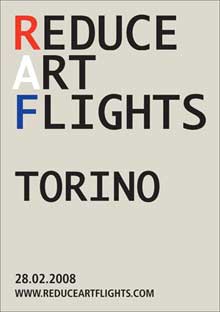 I, for one, can say proudly that i only drive bikes (i don’t have a driving license anyway) but when i saw the posters of RAF / Reduce Art Flights i could only laugh out loud at my own candor. I might not own a Hummer but i take an awful lot of planes for my work.
I, for one, can say proudly that i only drive bikes (i don’t have a driving license anyway) but when i saw the posters of RAF / Reduce Art Flights i could only laugh out loud at my own candor. I might not own a Hummer but i take an awful lot of planes for my work.
Initiated by Gustav Metzger, the RAF campaign upholds that the art world – artists, curators, critics, gallerists, collectors, museum directors, and art bloggers too i guess – could or should swap planes for less carbon dioxide-emitting transports.
The RAF acronym deliberately echoes the Royal Air Force – the aerial warfare branch of the British military – as well as the militant left-wing group known as the Red Army Faction. The message is communicated by mass-produced leaflets first distributed during Sculpture Projects Münster last Summer. The Turin version of the leaflet is available in art galleries and inserted into international mailings in connection with the exhibition.
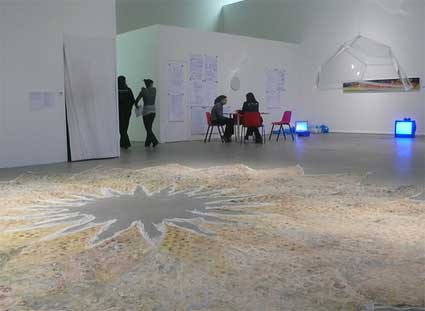 View of Beyond Pastoral (Shroud of Turin) at the Rebaudengo
View of Beyond Pastoral (Shroud of Turin) at the Rebaudengo
BP’s environmental record is pretty appalling. In 2000, British Petroleum changed its name to BP (Beyond Petroleum) and chose a yellow and green sunflower-like as its logo in a bid to highlight its interest in alternative and environmentally friendly fuels. Nevertheless BP was named one of the “ten worst corporations” in both 2001 and 2005 based on its environmental and human rights records.
The Bruce High Quality Foundation‘s installation Beyond Pastoral (Shroud of Turin) grows out of a project that the BHQF initiated for an exhibition in New York in 2007, which consisted of a 1/5 scale model of the BP petrol station located opposite the gallery, underneath which thousands of lemons and limes were arranged in the form of the BP logo.
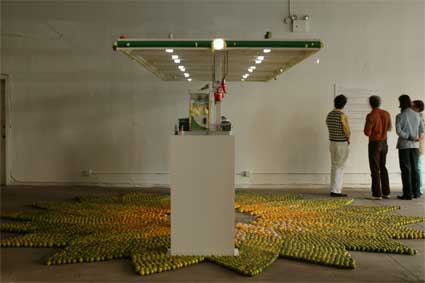 Installation in New York. Photo Oto Gillen
Installation in New York. Photo Oto Gillen
Each fruit was wired with electrodes and together they generated enough electrical current to illuminate the model. The irony of this seemingly earnest demonstration of an alternative energy source lies in the fact that the citruses quickly started to rot, posing a health hazard. Besides, transporting the fruit had required hundreds of liters of fuel. The Turin version of the work presented only the beautifully parched carpet of lemons and videos documenting the New York installation.
Beyond Pastoral exploit the power of faith, images and advertising in the new found religion of ‘green’ to further test the sustainability, credibility and authenticity of both corporate critique and supposedly miraculous technological promises.
A few weeks ago, i was in a museum bar in New York and almost fell of my chair when i was served a bottle of San Pellegrino, a water that (i think) comes from Lombardy in Italy. Minerva Cuevas‘s installation in Turin echoes our absurd and eco-damaging fetishism for “exotic” waters.
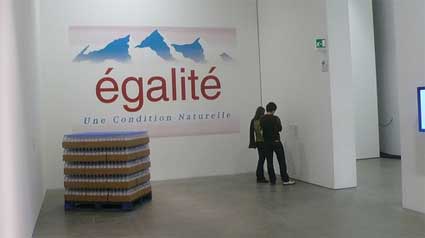 Égalité (2003) also involves the sabotaging of a corporate graphic identity. Owned by the Danone group, Evian is probably the world’s best-known bottled water. Considering that the global market for bottled water multiplied more than 1000 times in the last decade – its average price is more than that of petrol – Cuevas has kept the shape and design of the bottle intact. Bar one detail: she replaced the familiar brand’s lettering by Égalité, as in France’s motto, ‘Liberté, égalité, fraternité’ (Liberty, equality, fraternity), subtly pointing out political issues linked to water throughout the world nowadays.
Égalité (2003) also involves the sabotaging of a corporate graphic identity. Owned by the Danone group, Evian is probably the world’s best-known bottled water. Considering that the global market for bottled water multiplied more than 1000 times in the last decade – its average price is more than that of petrol – Cuevas has kept the shape and design of the bottle intact. Bar one detail: she replaced the familiar brand’s lettering by Égalité, as in France’s motto, ‘Liberté, égalité, fraternité’ (Liberty, equality, fraternity), subtly pointing out political issues linked to water throughout the world nowadays.
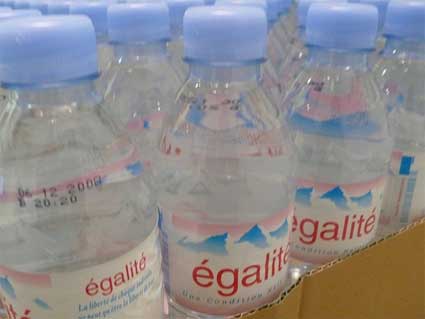
There is little equality as far as access to water is concerned, and those who have a seemingly unlimited access to it would rather pay ridiculous prices for something that comes almost freely from a tap.
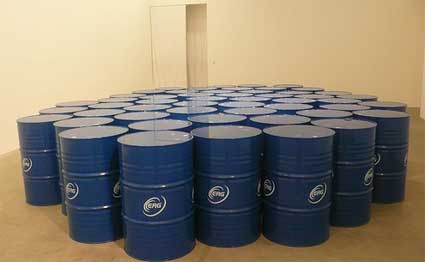 Wilfredo Prieto‘s Estanque installation is a congregation of crude oil barrels choreographed to look like an idyllic lily pond habitat complete with water puddles and a live frog (which had left the building when i visited the show).
Wilfredo Prieto‘s Estanque installation is a congregation of crude oil barrels choreographed to look like an idyllic lily pond habitat complete with water puddles and a live frog (which had left the building when i visited the show).
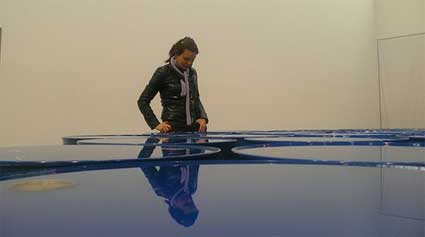 I’m the little frog on the oil pond!
I’m the little frog on the oil pond!
Petroleum oil, which is itself an organic substance, is converted by the sheer iconic power of its container into a symbol of all of the ills of our fossil-fuel dependency. Yet the sculpture inevitably suggests the prospect of eco-advertising, as if its graphic visual summary of apparent amphibian-petroleum harmony could perfectly lend itself to an audacious company marketing department in a bid to demonstrate their ‘green’ industrial principles.
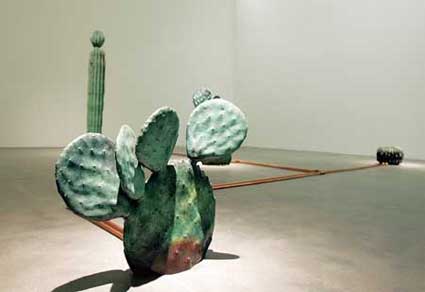 Simon Starling‘s ironic C.A.M. Crassulacean Acid Metabolism belongs to the artist’s fascinating series of “cactus works.” This installation is made of functioning cast iron radiators shaped like cacti and connected to a boiler with copper piping. The title of the work comes from a biochemical pathway that is a complex variation of photosynthesis, whereby some plants acquire carbon dioxide during the hours of darkness, minimizing thus eco-physiological stress and water loss from their leaves by avoiding gas exchange during the hot part of the day. C.A.M. opposes the supremely efficient and economical cactus strategy with the slightly ludicrous man-made radiators that expel heat into the exhibition space.
Simon Starling‘s ironic C.A.M. Crassulacean Acid Metabolism belongs to the artist’s fascinating series of “cactus works.” This installation is made of functioning cast iron radiators shaped like cacti and connected to a boiler with copper piping. The title of the work comes from a biochemical pathway that is a complex variation of photosynthesis, whereby some plants acquire carbon dioxide during the hours of darkness, minimizing thus eco-physiological stress and water loss from their leaves by avoiding gas exchange during the hot part of the day. C.A.M. opposes the supremely efficient and economical cactus strategy with the slightly ludicrous man-made radiators that expel heat into the exhibition space.
Jennifer Allora and Guillermo Calzadilla, whose life-sized clay hippopotamus had charmed me so much at the Venice Biennale in 2005, presented photos that document a participatory performance event they staged on the island of Vieques in March 2003 together with local residents and activist groups protesting against the U.S Military occupation of the island. The U.S had bought the land from the Puerto Rican government and had been using it for military exercises, and as a firing range and testing ground for bombs, missiles, and other weapons. The military experiments brought together with them severe ecological damage.
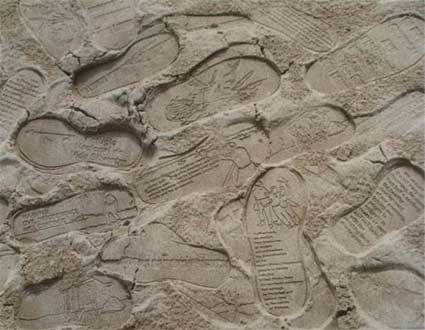 Jennifer Allora & Guillermo Calzadilla, Land Mark (Foot prints) #2, Set II, 2001-2004
Jennifer Allora & Guillermo Calzadilla, Land Mark (Foot prints) #2, Set II, 2001-2004
Allora & Calzadilla designed rubber shoe soles to be worn during actions of protest. When activists illegally entered the bombing range, they left behind indented messages for the US military staff. The imprints were a way of reclaiming the disputed territory, giving new power to the term “landmark.”
Today the contested territory, though still contaminated and debated, is a wildlife reserve under the protection of the US Fish and Wildlife Service.
Verdict: Greenwashing is a moving exhibition worth taking the train for if you ever come to Milan this month for the Salone del Mobile. I’m sure there will be some inspiring projects and gadgets presented this year at the international furniture fair. I wonder if any of them will have the strength of most of the artworks i discovered at the Fondazione Rebaudengo the other day.
I went camera-crazy again.
GREENWASHING will run at the Fondazione Sandretto Re Rebaudengo centre for contemporary art in Turin, Italy through 11 May 2008.
Related: Book review: Worldchanging: A Users Guide for the 21st Century; Ecological Strategies in Today’s Art (part 1 and 2).
Previously at the Fondazione Re Rebaudengo: Murakami exhibition in Turin.
Image on the homepage: Amy Balkin, Public Smog, 2004.

